Discover Setúbal Region: History, Beaches, Wine & Hidden Gems
October 1, 2025
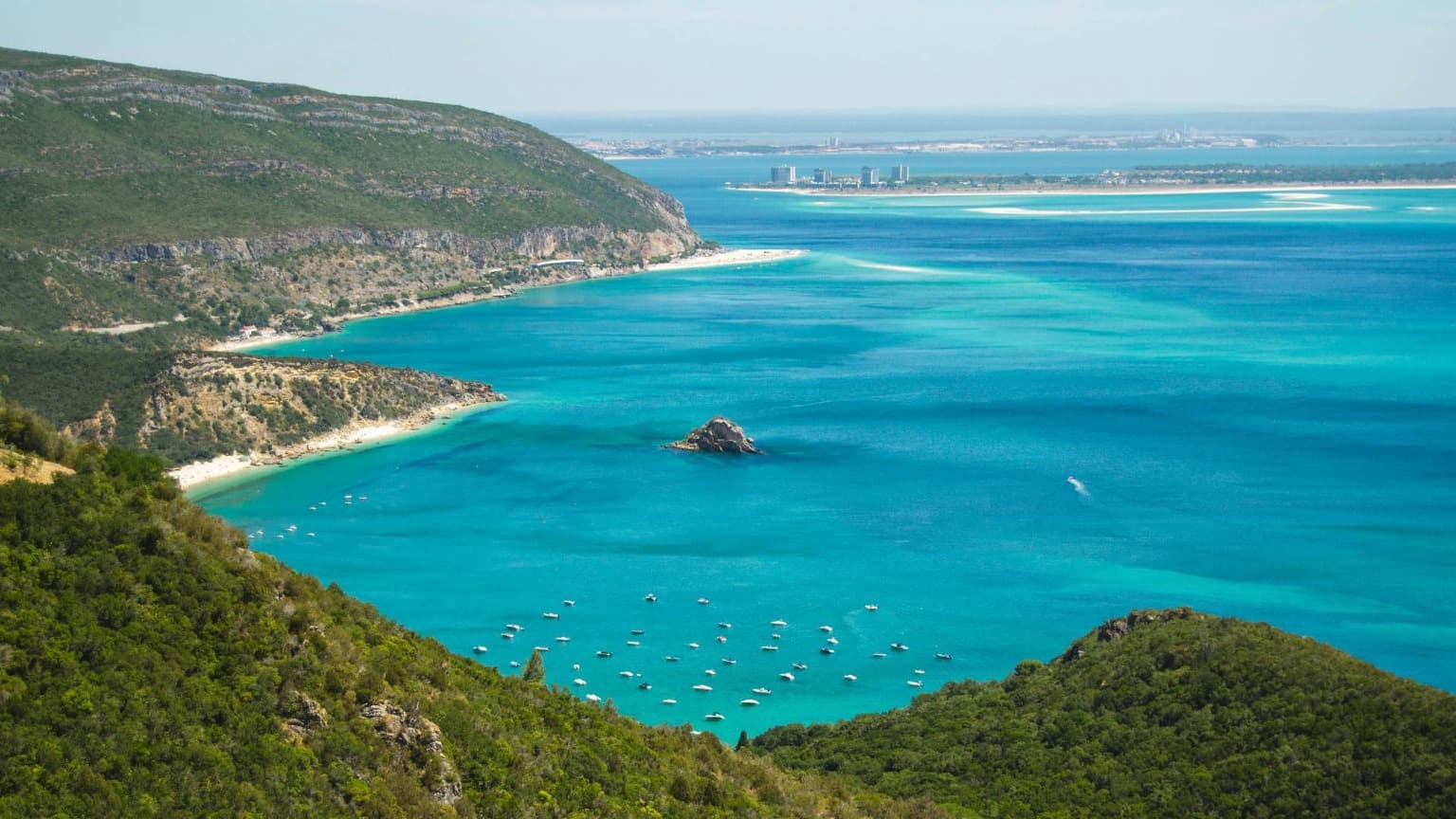
Panoramic view of Arrábida Natural Park with turquoise waters and the Tróia Peninsula in the background.
Nature, Culture & Gastronomy by the Atlantic
Just south of Lisbon, the Setúbal region offers the perfect blend of unspoiled beaches, lush mountains, historic towns, and world-class gastronomy.
From the turquoise waters of Arrábida to the traditional villages of Azeitão and Comporta, and from dolphin-watching in the Sado River to Moscatel wine tastings, this area is a must-see for anyone seeking an authentic side of Portugal.
If you haven’t booked your stay yet, Cooltour Oporto has curated a selection of the best eco-friendly hotels and accommodations. Check out our full guide to the best eco-sustainable accommodation in the Setúbal region here, or explore eco-friendly stays in Lisbon, Sintra, and Ericeira here for the perfect city-and-nature combination.
Whether you’re planning a day trip from Lisbon or a longer stay, Setúbal and its surroundings — Sesimbra, Arrábida, Comporta, and Tróia — combine nature, culture, and food in ways few regions can.
👉 If you’re also exploring Lisbon, don’t miss our complete Lisbon guide to combine your trip.
Highlights of the Setúbal Region
Setúbal – City of Dolphins & Flavors
The city of Setúbal, birthplace of poet Bocage and celebrated singer Luísa Todi, is a vibrant destination where history, culture, and gastronomy meet the beauty of the Atlantic coast. Known for its bustling markets, delicious seafood, and dolphin-filled waters, Setúbal is a perfect mix of tradition and authenticity. If you plan to explore the downtown area on foot, here are the main highlights from east to west:
On the East Side of Downtown
• Porta de São Sebastião – One of the old gateways to Setúbal’s medieval town, a reminder of its fortified past.
• Bairro de São Domingos – A traditional fishing neighborhood where narrow streets and local life reflect the city’s maritime heritage.
• Miradouro de São Sebastião (São Domingos Viewpoint) – A scenic lookout with sweeping views of the Sado River, the Tróia Peninsula, and the iconic Forte de São Filipe.
• Museu do Trabalho Michel Giacometti – An insightful museum housed in a former canning factory, showcasing Setúbal’s industrial and working-class history.
• Sé de Setúbal (Church of Santa Maria da Graça) – Originally founded in the 13th century and elevated to cathedral status in 1975, it blends Gothic and Manueline details.
In the City Center
• Avenida Luísa Todi – The city’s main boulevard, lined with leafy gardens, vibrant restaurants, and cultural venues.
• Praça do Bocage – Setúbal’s lively central square, framed by cafés, shops, and elegant historic buildings.
• Convento de Jesus – A Manueline masterpiece and one of the region’s architectural gems, located just a few minutes from the square.
On the West Side of Downtown
• Casa da Baía – Once an orphanage from 1750, this beautifully restored building now serves as a tourist and cultural center with exhibitions, local products, and wine tastings.
• Bairro do Troino – One of Setúbal’s most typical neighborhoods, dating back to Roman times. In the 18th century, it welcomed workers for the booming canning industry and still preserves its fishermen’s charm and lively spirit.
• Mercado do Livramento – Ranked by USA Today as one of the world’s best fish markets, famous for its fresh seafood stalls and colorful azulejo tiles.
• Avenida José Mourinho – Formerly Rua da Saúde, this riverside avenue now honors Portugal’s most famous football coach. It offers excellent restaurants, a relaxed waterfront atmosphere, and access to dolphin-watching experiences in the Sado estuary.
• Forte de São Filipe – Perched on a hilltop overlooking Setúbal, this 16th-century fortress offers breathtaking panoramic views of the city, the river, and Tróia. It’s reachable by car (around 4 minutes) or a scenic 20-minute walk.
💡 Traveler Tip: Don’t leave Setúbal without tasting the city’s iconic dish, Choco Frito à Moda de Setúbal (fried cuttlefish). And while you’re there, treat yourself to a chilled glass of Moscatel — the region’s signature wine.
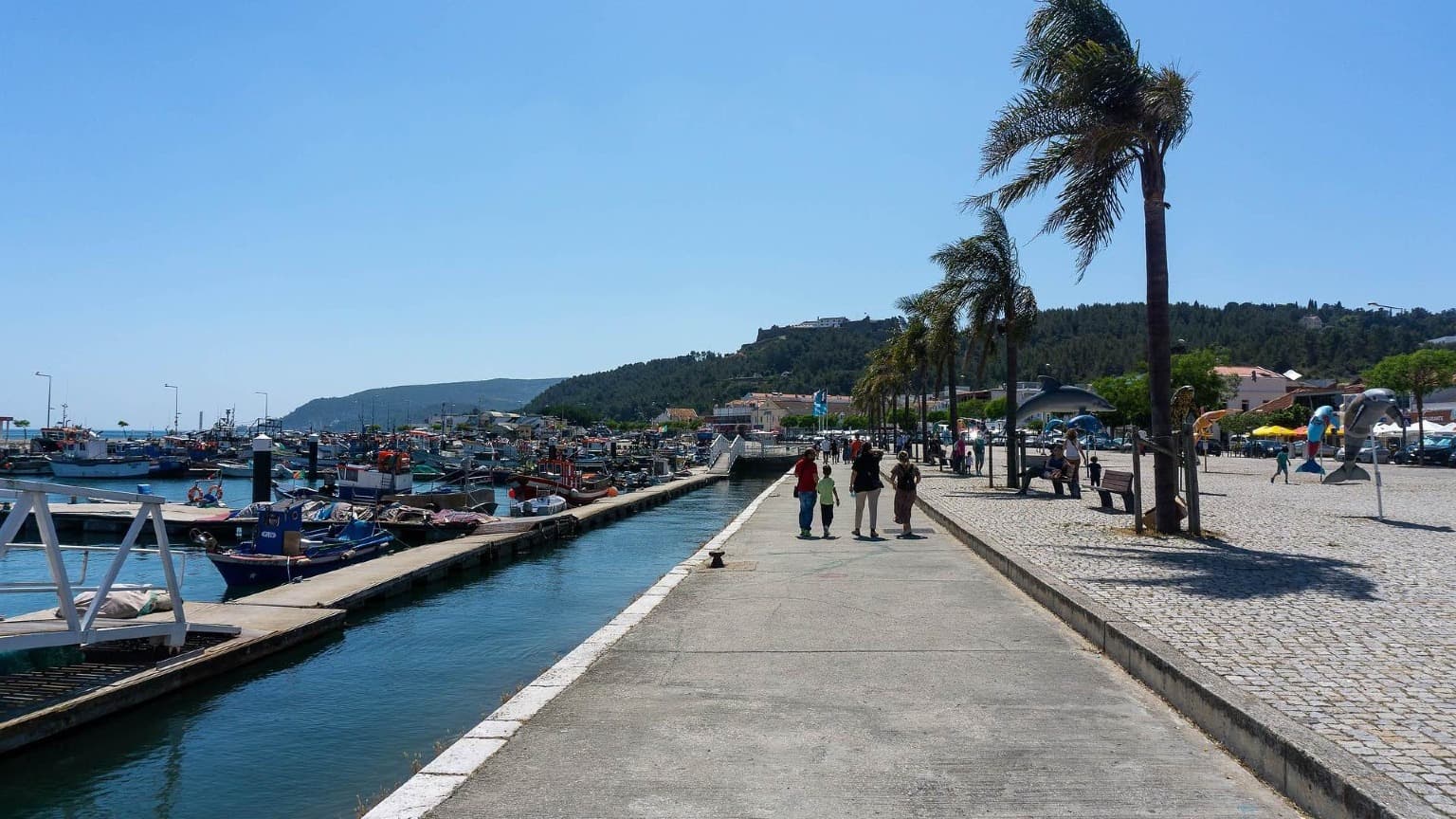
The lively Avenida José Mourinho in Setúbal, a waterfront promenade with restaurants and dolphin tours.
Arrábida Natural Park – Beaches & Secret Chapels
Just a short drive from Setúbal, the Arrábida Natural Park is a protected paradise of rolling green mountains, crystal-clear waters, and hidden cultural treasures. Stretching all the way to Sesimbra, this coastal haven is home to some of Portugal’s most breathtaking beaches and secret spots waiting to be discovered.
Must-See Beaches
• Praia dos Galapinhos – Often listed among the most beautiful beaches in Europe (highlighted by The Guardian), this sandy cove with turquoise waters feels like a tropical escape on the Portuguese coast.
• Praia dos Galapos & Praia dos Coelhos – Smaller, wilder, and less crowded than Galapinhos, these secluded gems are ideal for travelers looking for tranquility and unspoiled nature.
Scenic Viewpoints & Hidden Heritage
• Miradouro do Portinho da Arrábida – One of the park’s most stunning viewpoints, offering sweeping views over the bay and the turquoise sea framed by limestone cliffs.
• Convento da Arrábida – A 16th-century Franciscan monastery built into the hillside, where whitewashed chapels blend harmoniously with the lush green landscape.
• Lapa de Santa Margarida – Perhaps the park’s most magical hidden treasure: a seaside grotto that shelters a tiny chapel from the 17th or 18th century, accessible only through a steep and somewhat secret trail.
💡 Traveler Tip: The beaches of Arrábida are among the most popular day trips from Lisbon and Setúbal, so arrive early in summer months to secure parking and enjoy the serenity of the morning light. For a truly unique experience, consider exploring the coast by kayak or boat to access hidden coves and marine life.
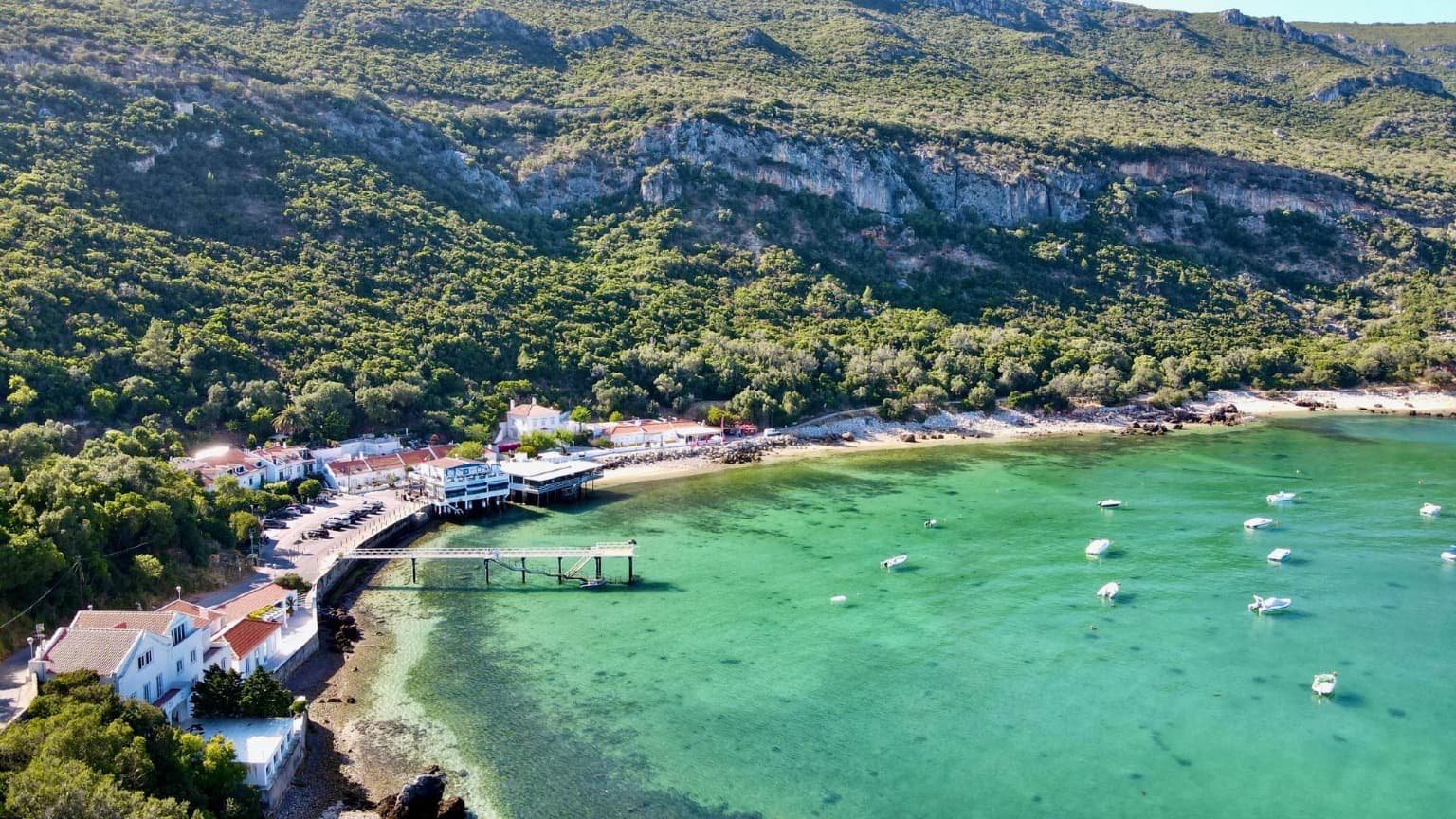
Portinho da Arrábida, a picturesque bay with calm waters and whitewashed houses at the foot of the mountains.
Sesimbra – Fishermen, Castles & Coastal Trails
Nestled between the Atlantic Ocean and the Arrábida hills, Sesimbra is a picturesque fishing town where tradition meets adventure. Known for its fresh seafood, medieval heritage, and spectacular coastline, it’s a favorite escape for both locals and travelers seeking authentic Portuguese charm.
Beaches & Seaside Promenade
• Praia da Califórnia & Praia do Ouro – Sesimbra’s two main beaches stretch along the lively town promenade, perfect for sunbathing, swimming, and enjoying the local atmosphere just steps from cafés and restaurants.
History & Culture
• Castelo de Sesimbra – Dating back to the 12th century, this hilltop castle offers sweeping views over the town, the bay, and the surrounding coastline. Walking its medieval walls is a journey back in time.
Hidden Natural Wonders
• Praia do Ribeiro do Cavalo – Often compared to the Caribbean for its turquoise waters and dramatic cliffs, this secluded beach can be reached by a challenging hike or a scenic boat ride — a true paradise for adventurers.
• Cabo Espichel & Sanctuary of Nossa Senhora do Cabo – A dramatic cliffside headland where faith and nature intertwine. The sanctuary has been a pilgrimage site for centuries, while nearby you can trace the fascinating dinosaur footprints preserved on the rocks.
💡 Traveler Tip: After a day of exploring, indulge in Sesimbra’s famous seafood restaurants — from freshly grilled fish to the legendary caldeirada (fish stew) — best enjoyed with ocean views and a glass of local white wine.
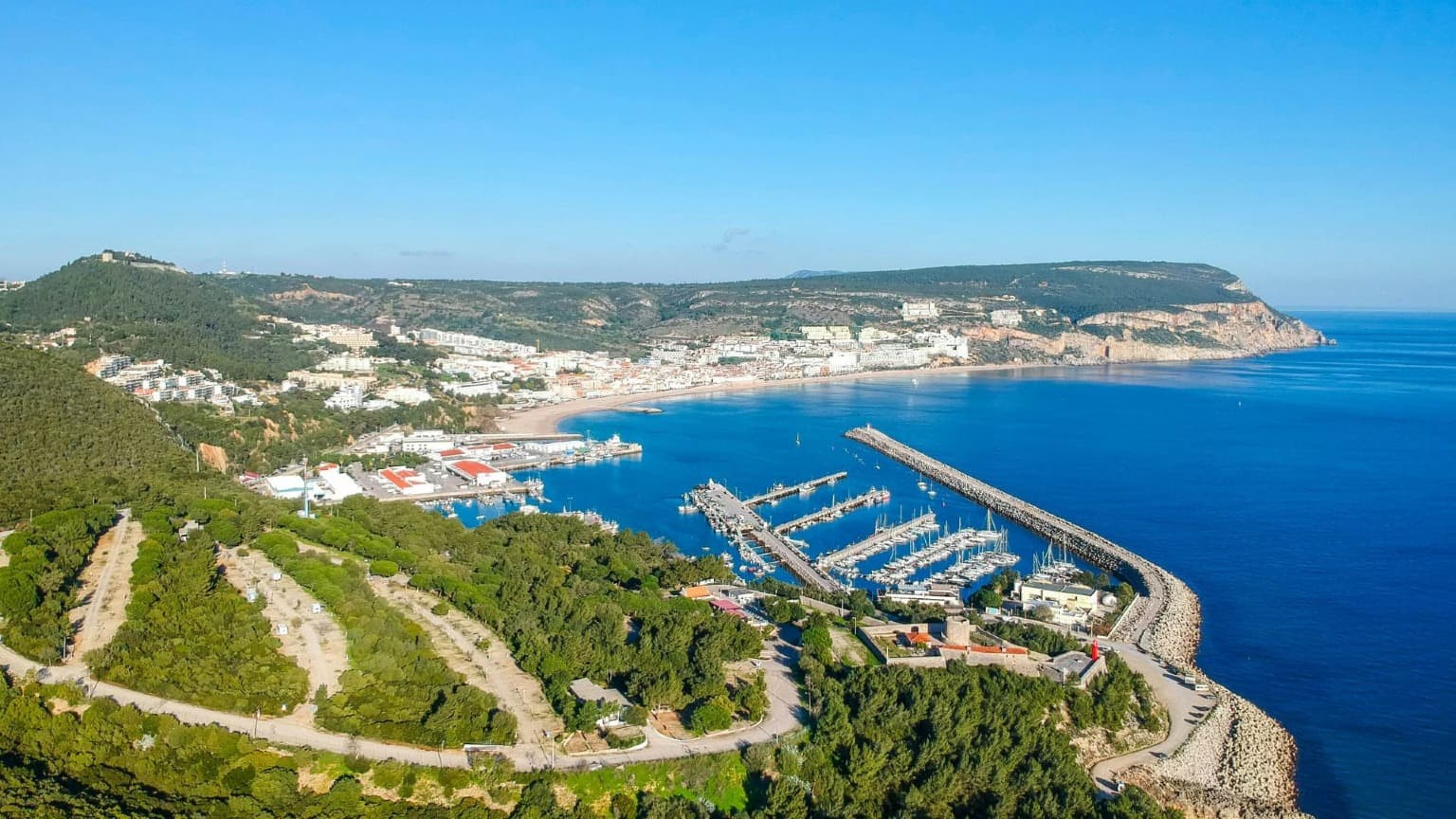
Sesimbra’s bay and fishing harbor, overlooked by the medieval castle and surrounded by the Arrábida hills.
Azeitão – Wine, Cheese & Azulejos
Hidden at the foothills of the Arrábida Mountains, the village of Azeitão is a haven for food and wine lovers, as well as a treasure trove of Portuguese craftsmanship. Famous for its Moscatel wines, creamy cheeses, and hand-painted azulejos, Azeitão offers a blend of gourmet delights and cultural heritage that make it a must-visit stop in the Setúbal region.
Wine & Palaces
• Casa Museu José Maria da Fonseca – One of Portugal’s oldest and most prestigious wineries, founded in the 19th century and internationally renowned for its Moscatel de Setúbal. Guided tours reveal centuries of wine-making tradition, culminating in a memorable tasting.
• Palácio da Bacalhôa – A Renaissance gem surrounded by vineyards and lush gardens, housing an impressive collection of art and azulejos. It’s one of the most striking examples of Portugal’s noble estates.
Local Flavors & Craftsmanship
• Pastelaria Regional Cego – The birthplace of the iconic Torta de Azeitão, a fluffy sponge roll filled with rich egg cream, best enjoyed with a glass of Moscatel.
• Azulejos de Azeitão – A family-run workshop where artisans continue the tradition of producing hand-painted Portuguese tiles, offering visitors the chance to see this centuries-old craft up close.
• Queijo de Azeitão – A soft and creamy sheep’s cheese with Protected Designation of Origin status, celebrated as one of Portugal’s finest gourmet cheeses.
💡 Traveler Tip: Combine a visit to Azeitão with a tour of the nearby Arrábida hills or Sesimbra for the perfect day trip — balancing cultural heritage, artisanal flavors, and natural beauty.
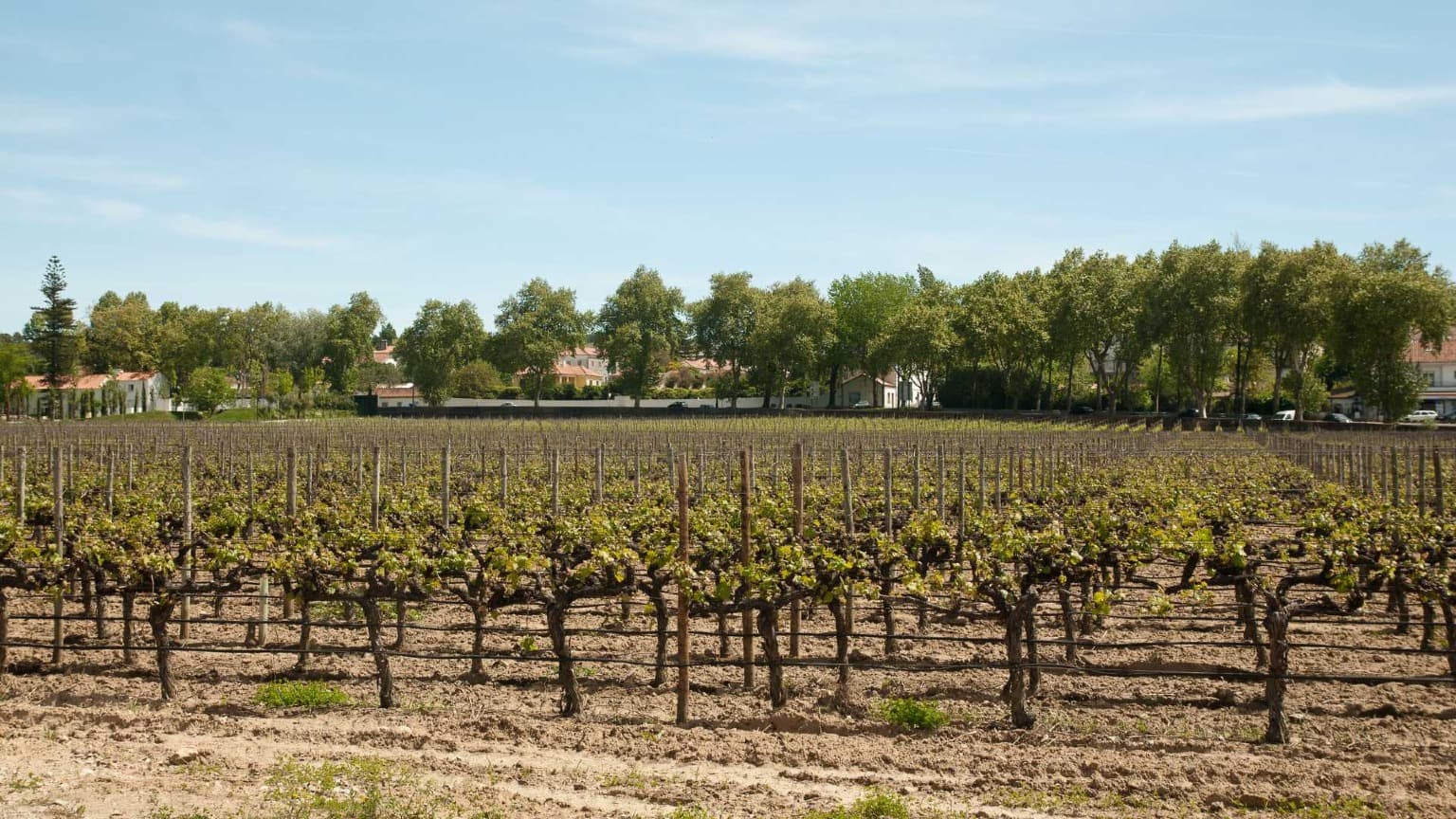
Vineyards of Palácio da Bacalhôa in Azeitão, one of Portugal’s most historic wine estates.
Comporta & Tróia – Chic Villages & Endless Sands
South of Setúbal, the Comporta and Tróia region offers a different rhythm of life: laid-back, stylish, and in harmony with nature. Often compared to the Algarve but far less crowded, this stretch of coast has become a haven for travelers seeking bohemian charm, luxury retreats, and endless golden sands.
Chic Villages & Relaxed Lifestyle
• Comporta Village – Famous for its effortlessly chic atmosphere, Comporta blends rustic authenticity with modern sophistication. Here, you’ll find designer boutiques, art galleries, and seafood taverns where simplicity meets elegance.
Beaches for Every Mood
• Praia da Comporta & Praia do Carvalhal – Expansive golden beaches lined with dunes, where upscale beach clubs coexist with quiet stretches of sand. Perfect for a lazy day of sunbathing or a stylish lunch by the sea.
• Praia de Melides – A wilder and more rugged alternative, ideal for those seeking tranquility and natural beauty away from the main hubs.
Unique Experiences
• Cais Palafítico da Carrasqueira – One of Portugal’s most photogenic spots, this stilt harbor with wooden piers stretching into the marshlands is a masterpiece of traditional fishing culture. Best visited at sunset for magical views.
• Ilha de Tróia – Reachable by ferry from Setúbal, Tróia offers pristine beaches, Roman ruins at Cetóbriga, and unforgettable dolphin-watching cruises in the Sado estuary.
💡 Traveler Tip: The Comporta area has become a discreet hotspot for international artists and designers. For the full experience, pair a beach day with a dinner at a local seafood restaurant, accompanied by a chilled glass of white wine from the Setúbal Peninsula.
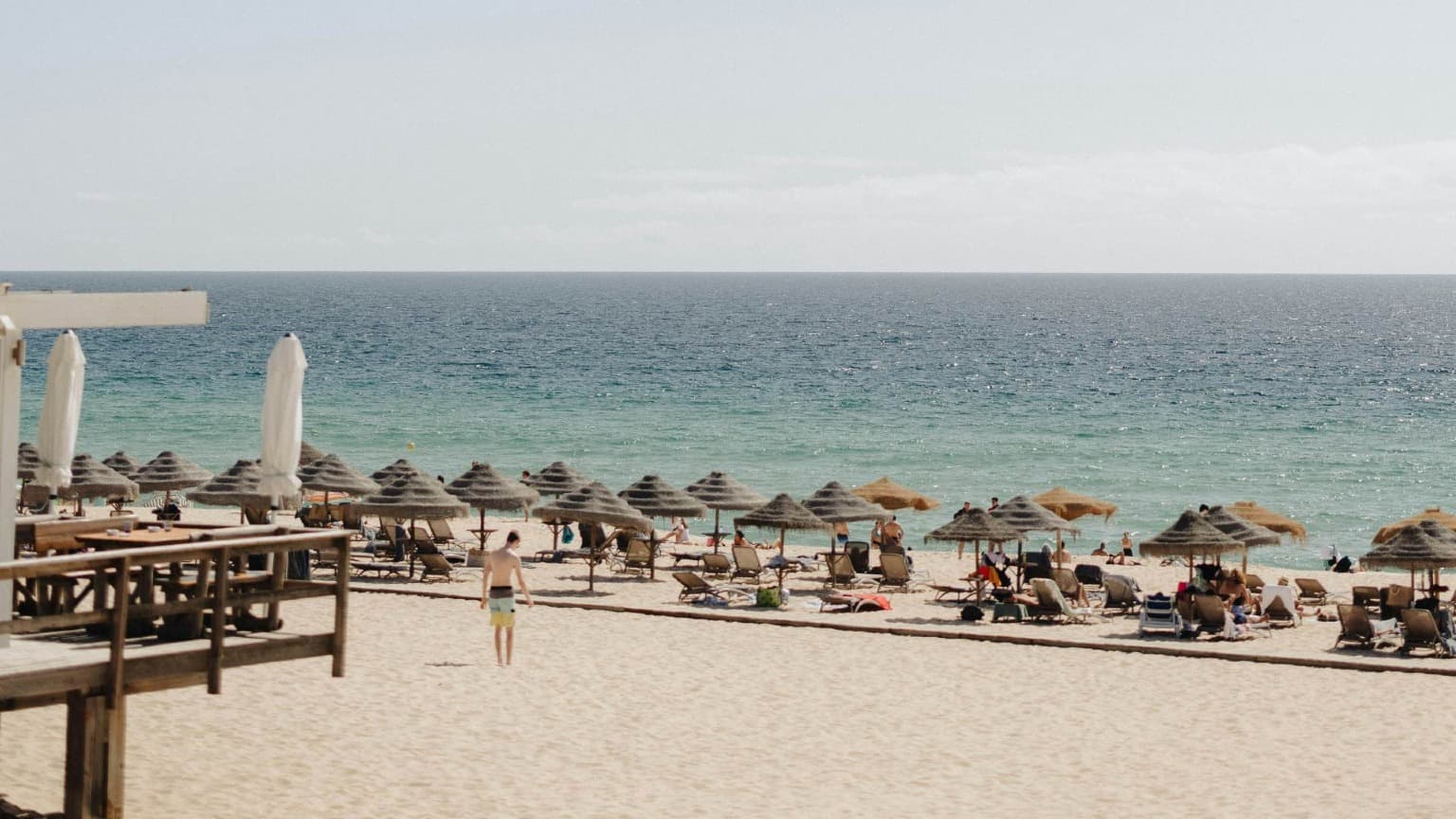
Praia da Comporta, a chic sandy beach with straw umbrellas and relaxed seaside vibes.
Gastronomy of Setúbal Region
The Setúbal Peninsula is a foodie’s dream, where Atlantic seafood meets local wine and sweets. Must-tries include:
• Choco Frito à Moda de Setúbal – Fried cuttlefish, the city’s signature dish.
• Cataplana de Peixe e Marisco – A seafood stew cooked in a copper pan.
• Ostras do Sado – Fresh oysters harvested from the Sado estuary.
• Torta de Azeitão – A sweet rolled sponge filled with egg cream.
• Queijo de Azeitão – Creamy sheep’s cheese with a strong flavor.
• Moscatel de Setúbal – A fortified wine with international fame.
Top 11 Restaurants in Setúbal Region
From traditional taverns to Michelin-inspired menus, here are standout options:
• Casa Santiago (Setúbal) – Legendary for its fried cuttlefish.
• Tasca da Avenida (Setúbal) – Local flavors with friendly service.
• Feito ao Bife (Setúbal) – Steakhouse with a Portuguese twist.
• Xtoria (Setúbal) – Contemporary fine dining.
• Casa Mateus (Sesimbra) – Fresh fish and seafood by the sea.
• O Zagaia (Sesimbra) – Traditional flavors with generous portions.
• O Farol (Arrábida) – Classic seafood in Portinho da Arrábida.
• Comporta Flavours (Comporta) – A relaxed spot highlighting regional cuisine.
• Mesa Comporta (Comporta) – Chic yet rustic, with seasonal dishes.
• Moments Lounge (Palmela) – Mediterranean cuisine with a modern touch.
• Taverna Bobo da Corte (Palmela) – Tavern vibes with hearty Portuguese plates.
Hidden Gems of the Setúbal Region
Beyond its famous beaches, markets, and historic towns, the Setúbal region hides a treasure trove of secret spots waiting to be uncovered. These off-the-beaten-path gems are perfect for travelers who want to go deeper and experience the region’s most authentic and surprising side.
• Cais Palafítico da Carrasqueira (Comporta) – A surreal landscape of wooden piers and fishermen’s huts built on stilts over the marshes. This atmospheric spot is one of Portugal’s most unique photo opportunities, especially at sunset.
• Lapa de Santa Margarida (Arrábida) – A secret seaside grotto where a small 17th-century chapel clings to the rocks. Hidden down a steep path, it offers a truly magical mix of spirituality and nature.
• Parque de Merendas do Alambre (Arrábida) – More than just a picnic park, this area serves as a gateway to hiking trails through cork forests and limestone hills, rewarding explorers with panoramic views of the Arrábida mountains and coastline.
• Palmela Castle – Often overshadowed by Sesimbra and Setúbal, this medieval fortress offers sweeping views over vineyards, the Tagus estuary, and even Lisbon on a clear day. Its blend of history and scenery makes it one of the region’s most underrated spots.
💡 Traveler Tip: Hidden gems often require extra effort to reach — whether it’s a hike, a short drive, or fewer tourist facilities. Pack comfortable shoes, water, and curiosity, and you’ll be rewarded with some of the most unforgettable experiences in Setúbal.
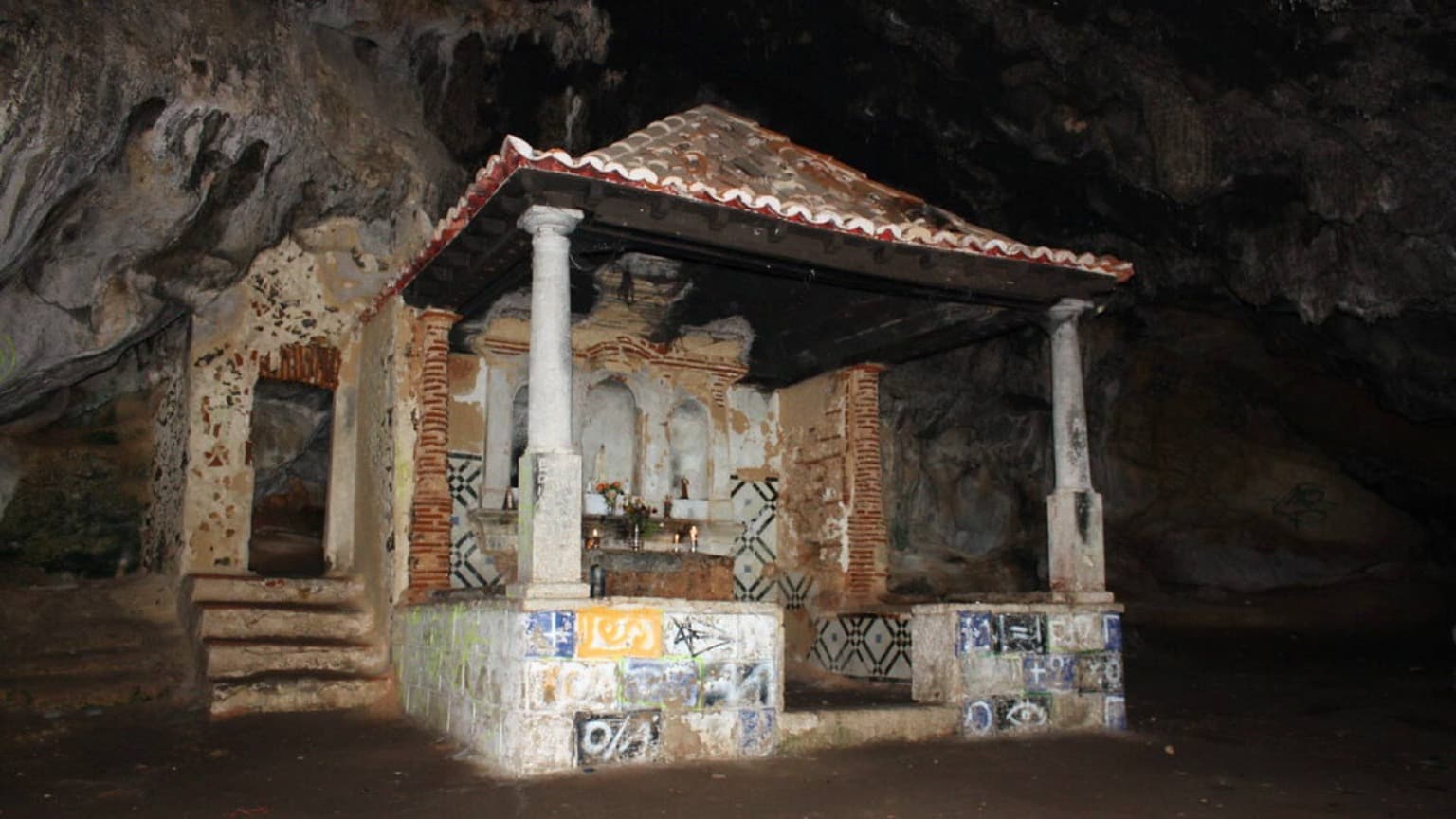
The hidden Lapa de Santa Margarida grotto in Arrábida, with a small 17th-century chapel inside the cave.
FAQ: Visiting the Setúbal Region
Q: How far is Setúbal from Lisbon and how do I get there?
A: Setúbal is about 50 km south of Lisbon. By car, the drive takes around 45–50 minutes, and by train from Lisbon’s Campolide or Entrecampos stations, it’s about one hour. This makes Setúbal ideal for a day trip from Lisbon or a longer stay to explore the region.
Q: What are the best beaches in the Setúbal region?
A: Some of Portugal’s most stunning beaches are found here. Highlights include Praia dos Galapinhos, once voted one of Europe’s most beautiful; Praia de Coelhos and Praia dos Galapos for smaller, quieter coves; and Praia do Ribeiro do Cavalo near Sesimbra, often compared to the Caribbean. For wide sandy stretches with beach clubs, head to Comporta and Tróia.
Q: What are the top things to do in Setúbal and nearby?
A: Popular activities include dolphin-watching cruises in the Sado River, wine tastings in Azeitão (famous for Moscatel wines), exploring the Arrábida Natural Park with its chapels and hiking trails, and visiting castles in Sesimbra and Palmela. Food lovers should not miss the Mercado do Livramento fish market in Setúbal.
Q: What food and drinks is Setúbal known for?
A: The city’s signature dish is Choco Frito à Moda de Setúbal (fried cuttlefish). Other regional specialties include fresh Sado River oysters, creamy Queijo de Azeitão (sheep’s cheese with PDO status), the sweet Torta de Azeitão, and of course, the renowned Moscatel de Setúbal wine.
Q: Is the Setúbal region family-friendly?
A: Yes. Many beaches, especially around Tróia and Comporta, have calm waters suitable for children. Families can also enjoy boat trips, nature walks in Arrábida, dolphin-watching tours, lively markets, and cultural sites that appeal to all ages.
Q: Is Setúbal worth visiting compared to the Algarve?
A: Absolutely. While the Algarve is more famous, Setúbal offers a more authentic Portuguese experience with fewer crowds. Here you’ll find world-class beaches, gourmet food, wine culture, and historic towns — all within an hour of Lisbon.
💡 Traveler Tip: Combine Setúbal with day trips to Sesimbra, Azeitão, Arrábida, and Comporta for a complete experience of the region’s beaches, wine, food, and culture.
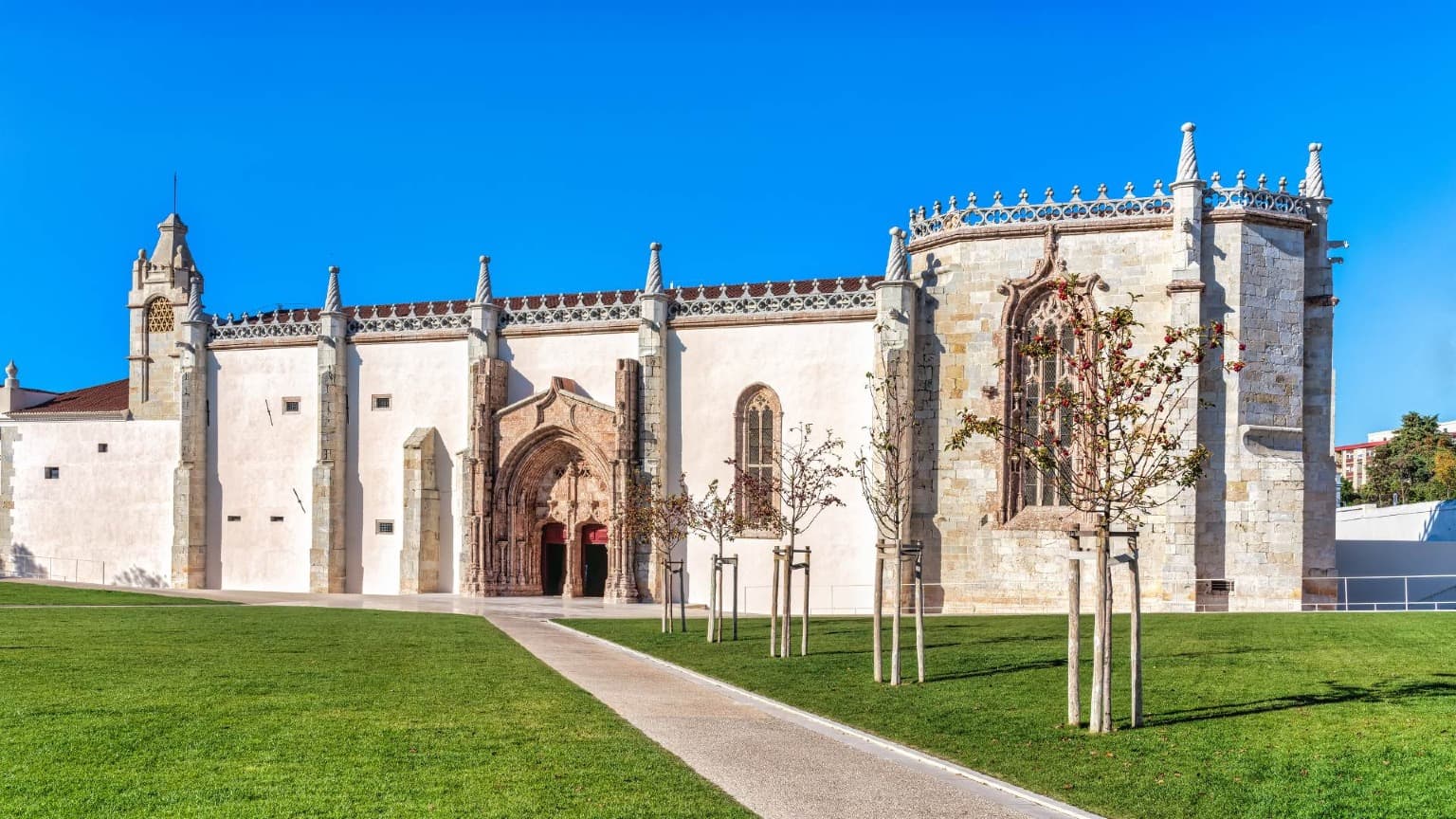
The 15th-century Convento de Jesus in Setúbal, a Manueline masterpiece and cultural landmark of the region.
Plan Your Setúbal Region Experience
From dolphins in the Sado River to secret chapels in Arrábida, from Sesimbra’s medieval castles to Comporta’s chic golden sands, the Setúbal region is one of Portugal’s most captivating destinations — authentic, diverse, and still a well-kept secret.
➡️ At Cooltour Oporto, we partner only with trusted guides and sustainable operators to bring you experiences that are authentic and lower in environmental impact. Our Marketplace already features a Private Setúbal Walking Tour, and more eco-conscious activities — including dolphin-watching cruises — will be added soon.
Book your private Setúbal walking tour today and explore the region sustainably with Cooltour Oporto.